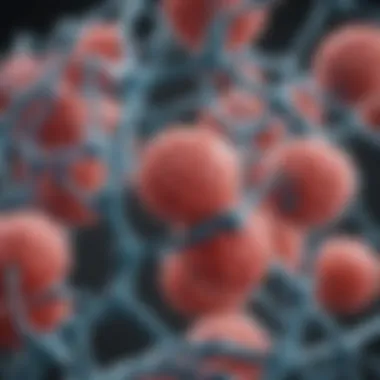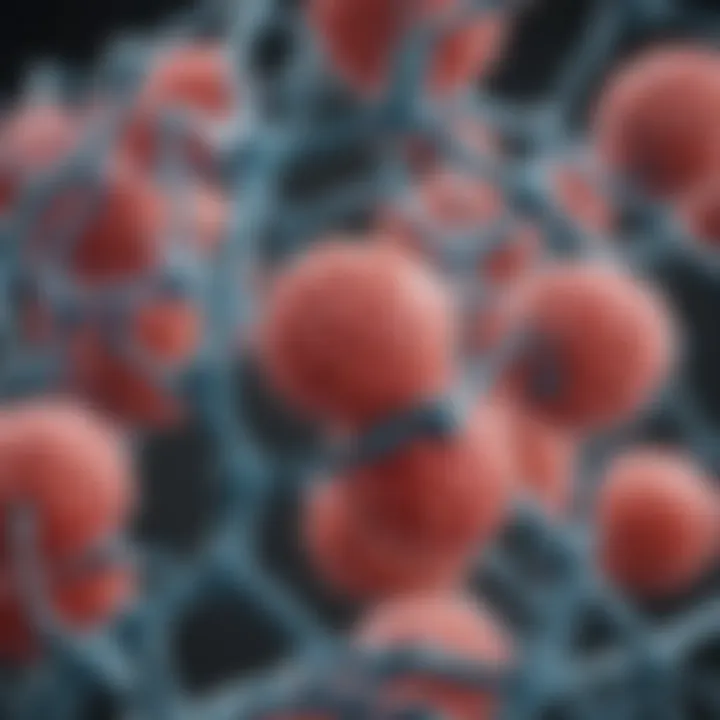Urease Enzyme: Key Player in Nitrogen Cycle


Intro
Urease is a remarkable enzyme central to numerous biological processes. Its primary function is to catalyze the hydrolysis of urea into ammonia and carbon dioxide. This reaction is a key step in the nitrogen cycle, where nitrogen is transformed into forms that organisms can utilize. Understanding urease is essential not only for biochemists but also for professionals in agriculture, medicine, and environmental science.
The significance of urease extends beyond its basic function. The enzyme plays a critical role in various ecosystems, influencing soil health and nutrient availability. In agricultural settings, urease affects fertilizer efficiency, which can impact crop yields. In medicine, it can be related to certain pathologies and is a target for some therapeutic approaches. Thus, urease stands as a pivotal molecule whose study reveals insights into both biological function and practical applications.
Recent Advances
Latest Discoveries
Recent research has shed light on the intricate workings of urease at a molecular level. Scientists have explored the enzyme's structure, revealing that it consists of multi-subunit complexes. This multi-level architecture is essential for its catalytic activity. Studies have also identified how variations in metal ions within the urease structure can influence activity and stability. Specifically, nickel and cobalt have emerged as crucial for urease function in many organisms.
Moreover, new pathways in urease expression regulation have been identified, transforming our understanding of how organisms adapt to nutrient stresses. Gene editing technologies, like CRISPR, are being utilized to study urease genes, opening pathways for genetic modifications aimed at enhancing agricultural yields.
Technological Innovations
Innovations in analytical techniques have also advanced the study of urease. Mass spectrometry and cryo-electron microscopy allow researchers to visualize the enzyme and its substrates with unprecedented resolution. These technologies contribute substantially to a more profound understanding of urease's role in biological systems.
Additionally, biosensor technologies are being developed to measure urease activity in real-time. This ability can lead to better agriculture practices by enabling precise management of fertilizer use, minimizing environmental impacts while maximizing crop output.
Finale
The exploration of urease highlights its multifaceted significance in biological systems. From its foundational role in nitrogen fixation to its implications in sustainable agriculture and health, urease is a subject of ongoing importance. The synergy between recent discoveries and technological advancements accelerates our understanding and application of this vital enzyme. As research continues, the potential benefits stretch across various fields, emphasizing the need for continuous exploration in this domain.
Prelude to Urease
Urease is not merely an enzyme; it serves as a critical component in various biological processes. Its primary function is to catalyze the hydrolysis of urea into ammonia and carbon dioxide, which holds significant ramifications for the nitrogen cycle. This enzymatic activity is vital for many organisms and consequently, for the ecosystems they inhabit. Understanding urease offers insights into nutrient cycling, soil fertility, and the delicate balance of agricultural practices. As we explore this topic, it becomes apparent that urease transcends simple biochemical interactions and touches on multiple aspects of both environmental sustainability and agricultural productivity.
Definition and Overview
Urease is an enzyme that plays an essential role in the breakdown of urea, a nitrogenous compound found in various biological fluids and materials. It facilitates the reaction that converts urea into ammonia and carbon dioxide:
(NH₂)₂CO + H₂O → 2 NH₃ + CO₂
Ammonia produced through this reaction can then be utilized by plants as a nitrogen source, promoting growth and health. Urease is prevalent in bacteria, fungi, and certain plants, demonstrating its fundamental nature in various biological systems. With variations in structure and function across species, urease maintains a consistent role in nitrogen metabolism, making it an enzyme of great significance.
Historical Perspective
The study of urease dates back to the 19th century. Initial investigations highlighted its presence in various biological sources, notably in the seeds of jack beans. The discovery of urease's catalytic properties marked a turning point in understanding nitrogen metabolism. Early researchers, such as J. M. G. Merck and others, described its activity and began to appreciate its broad implications.
Over the decades, advances in protein chemistry and enzymology allowed for more detailed studies on urease's structure and operational mechanisms. As researchers delved deeper, the enzyme's importance became clear, extending its relevance from basic biology to real-world applications in agriculture and environmental science. Today, urease research continues to evolve, encompassing genetic engineering and nanotechnology, revealing new dimensions of this vital enzymatic process.
Understanding urease is pivotal, as it relates to key processes in nitrogen cycling and environmental sustainability.
The exploration of urease thus sets the stage for a detailed examination of its biochemical properties, roles in the nitrogen cycle, and applications in agriculture and beyond.
Biochemical Properties of Urease
The biochemical properties of urease are essential to understanding its pivotal role in various biological systems. Urease is not just a mere catalyst; it has unique structural features and mechanisms that contribute to its specific functions. This section examines the enzyme's structure, action mechanism, and factors impacting its activity. Each of these elements offers insights into how urease operates within its biological contexts and its overall significance.
Enzyme Structure
Urease is a nickel-containing enzyme composed of multiple subunits. It usually exists as a dimer or tetramer, depending on the organism. Structurally, urease features a complex arrangement that facilitates the binding of urea. The active site of urease binds to urea and contains essential nickel ions, which play a crucial role in its catalytic activity.
This specific architecture is vital, as it allows urease to facilitate the hydrolysis of urea efficiently. Without this intricate structure, the enzyme would not achieve the high turnover rates observed in biological systems. The precise arrangement of amino acids in the active site is tailored to promote the conversion of urea into ammonia and carbon dioxide.
Mechanism of Action
The mechanism of action for urease involves several key steps. First, urea binds to the active site of the enzyme. Following binding, urease catalyzes the hydrolysis of urea, a reaction that produces ammonia and carbon dioxide. This reaction is primarily facilitated by the coordination of water molecules by the nickel ion in the active site.
The reaction proceeds in two stages: the formation of a carbamoyl intermediate and the release of ammonia. The efficiency of this catalytic process is largely a result of the enzyme's ability to stabilize the transition state, lowering the activation energy required for the reaction. Consequently, the mechanism highlights how urease contributes significantly to nitrogen recycling in ecosystems.
Factors Affecting Activity


Several factors influence the activity of urease, including pH, temperature, and the presence of inhibitors. Optimal pH levels generally range from 6.0 to 7.5, where urease exhibits peak activity. Deviations from this range can result in reduced enzymatic efficiency.
Temperature also plays a critical role. Urease generally shows increased activity at moderate temperatures, but excessive heat can lead to denaturation and loss of function. Additionally, various substances may inhibit urease activity. For instance, the presence of heavy metals or certain toxins can disrupt the enzyme's structure, impacting its functions.
In summary, understanding the biochemical properties of urease provides critical insights into its functionality and relevance within biological systems. Researchers must consider these factors to optimize urease's practical applications in agriculture, environmental science, and medicine.
Urease in the Nitrogen Cycle
Urease serves a pivotal role in the nitrogen cycle, acting as a catalyst for the hydrolysis of urea to ammonia and carbon dioxide. This enzymatic reaction is crucial for the conversion of nitrogen into forms that can be utilized by living organisms. Understanding the functions and mechanisms of urease within the nitrogen cycle is fundamental to recognizing its benefits to ecological and agricultural systems.
Role in Nitrogen Transformation
The primary function of urease in the nitrogen cycle is to facilitate nitrogen transformation. When urea, a common nitrogenous waste product of animals, is present in soil, urease hydrolyzes it into ammonia. This reaction is vital for several reasons:
- Biological Availability: The ammonia produced can be assimilated by plants, making nitrogen available for their growth. Plants utilize ammonia to synthesize amino acids and other essential compounds.
- Environmental Impact: Ammonia can further undergo nitrification, converting into nitrites and nitrates. These compounds are integral to the nitrogen cycle as they help sustain various forms of life, including plants and heterotrophs.
- Soil Microbial Activity: The presence of ammonia enhances microbial activity in the soil, promoting the decomposition of organic matter and aiding in nutrient recycling. Effective nitrogen transformation leads to robust soil health, benefiting ecosystems.
Impact on Soil Fertility
Urease significantly influences soil fertility through its role in the nitrogen cycle. The hydrolysis of urea by urease directly impacts the fertility of the soil in multiple ways:
- Nutrient Supply: By converting urea into ammonia, urease provides a steady supply of nitrogen, which is one of the three essential macronutrients for plants, alongside phosphorus and potassium.
- Enhanced Crop Yields: The increased availability of nitrogen leads to improved crop productivity. Farmers can achieve higher yields by applying urea-based fertilizers, thanks to the action of urease in breaking down these fertilizers.
- pH Modification: The conversion of urea to ammonia can influence the soil pH, often increasing alkalinity. This can impact nutrient availability and microbial life, creating a more balanced ecosystem.
"Increasing urease activity in soils can enhance nitrogen transformation efficiency and promote sustainable agriculture."
Overall, the role of urease in the nitrogen cycle cannot be underestimated. Through its transformative actions, it ensures the availability of nitrogen for plants, contributes to soil fertility, and supports rich ecosystems. The enzyme's mechanism is essential for the sustenance of both agricultural and natural landscapes.
Urease and Plant Physiology
Urease enzyme holds significant importance in plant physiology, particularly due to its role in metabolizing urea. This is essential for plants as they utilize nitrogen for growth and development. Urea presents a major nitrogen source, especially in agricultural practices where urea-based fertilizers are common. Understanding urease's functionality aids in grasping how plants absorb and utilize nitrogen efficiently.
Urease in Plant Metabolism
Urease catalyzes the hydrolysis of urea, producing ammonia and carbon dioxide. This means that urease directly influences how plants access nitrogen. Once urea is broken down, ammonia enters metabolic pathways that synthesize essential amino acids and nucleotides, which are vital for plant growth.
- Nitrogen Assimilation: Ammonia produced during urea hydrolysis is incorporated into organic compounds. This is crucial for forming proteins and other nitrogenous compounds.
- Energy Efficiency: The process also influences energy expenditure. Plants can conserve energy by utilizing urea instead of relying solely on more complex nitrogen sources.
- Growth Regulation: Adequate nitrogen levels enhance plant growth, but excess nitrogen can lead to other issues. Understanding how urease regulates nitrogen availability is paramount for optimal plant health.
In summary, urease plays a foundational role in plant metabolism by converting urea into usable nitrogen forms. The efficiency of this enzyme can determine overall plant yield and health.
Plants Utilizing Urease
Many plant species have adapted to utilize urease as part of their nitrogen uptake strategy. This adaptation is particularly significant in environments where nitrogen is limited in the soil.
- Leguminous Plants: Plants such as Medicago sativa (alfalfa) show remarkable urease activity. They often thrive in nitrogen-poor soils, leveraging this enzyme to optimize their resource utilization.
- Cereal Crops: Species like wheat and maize also benefit from urease activity, especially when urea fertilizers are applied during growth stages.
Urease in Microbial Systems
Urease plays a significant role in microbial systems, contributing to nitrogen metabolism and influencing various ecological functions. Microbes, especially bacteria, use urease to catalyze the hydrolysis of urea into ammonia. This process is crucial not only for microbial growth but also for nutrient cycling in the environment. The benefits of urease production extend to agricultural settings, where it enhances soil fertility and promotes plant growth.
Bacterial Urease Production
Bacteria such as Proteus mirabilis and Klebsiella pneumoniae exhibit high urease activity, which serves vital functions in their ecological roles. The production of urease allows these bacteria to thrive in nitrogen-poor environments. The enzyme translates urea, a compound found in many environments, into ammonia, which can be used by the bacteria themselves and other organisms as a nitrogen source.
- Key Points of Bacterial Urease Production:
- Converts urea into ammonia.
- Supports bacterial survival in nitrogen-scarce habitats.
- Enhances nitrogen availability in soil.
The mechanism of urease production is well-regulated, ensuring that these bacteria can respond to environmental cues. Factors such as urea concentration, pH, and temperature can influence enzyme expression. This adaptability highlights the intricate connection between microbial metabolism and environmental conditions.
Role in Symbiotic Relationships
Urease also plays a significant role in symbiotic relationships, notably between certain bacteria and host plants. For instance, some leguminous plants engage with ureolytic bacteria, which produce urease. The ammonia generated from urea hydrolysis benefits the plant, providing essential nitrogen for growth.
"The relationship between urea-producing microbes and plant hosts exemplifies a critical mutualism that sustains ecosystem productivity."
- Key Aspects of Symbiotic Relationships:


- Urease promotes nitrogen availability.
- Supports plant health and productivity.
- Enhances microbial survival within the plant system.
Through these interactions, urease not only enhances nitrogen utilization but also contributes to the overall health of ecosystems. Understanding the dynamics of urease in microbial systems is essential for applications in agriculture and environmental management, emphasizing its pivotal role in sustaining biological systems.
Applications of Urease in Agriculture
Urease has significant implications for modern agricultural practices. Its role in enhancing soil fertility and optimizing fertilizer use is of utmost importance. By understanding how urease functions, farmers and agronomists can better leverage its properties to improve crop yields and sustainability. The various applications of urease not only contribute to agricultural productivity but also address environmental concerns associated with nitrogenous waste.
Soil Amendment Practices
In agricultural practices, soil amendment is essential for maintaining soil health and fertility. Urease plays a crucial role in this process by facilitating the breakdown of urea in the soil. When urea is applied as a fertilizer, urease catalyzes its hydrolysis into ammonia and carbon dioxide.
This process enhances nitrogen availability for plants, promoting growth. However, there are factors to consider. Applying urease-rich products can help in controlling the rate of urea hydrolysis, ensuring that nitrogen is released gradually, which is ideal for crops. Additionally, it minimizes nitrous oxide emissions, a potent greenhouse gas resulting from nitrification processes in soil.
- Key aspects of soil amendment:
- Improvement of soil structure: Urease can help to facilitate better soil aggregation.
- Enhanced nutrient retention: By increasing organic nitrogen content, urease aids in retaining essential nutrients.
- Environmental benefits: Reduces nitrogen leaching and helps in maintaining groundwater quality.
Enhancing Fertilizer Efficiency
The efficiency of fertilizers is a major concern in agriculture today. Urease plays a pivotal role here as well. By enhancing the efficiency of applied fertilizers, it is possible to reduce the amount of nitrogen needed and therefore minimize both costs and environmental impact.
Applying urease inhibitors can regulate nitrogen release and improve fertilization efficiency. These inhibitors prolong the action of urease in the soil, allowing for a slow release of ammonia. This gradual release matches the nutrient uptake pattern of plants, ensuring they have access to nitrogen when needed.
- Advantages of using urease in fertilizer systems:
- Cost savings: Reduces the need for frequent fertilizer applications.
- Maximized nutrient utilization: Plants utilize nitrogen more effectively, leading to improved growth and productivity.
- Reduced environmental footprint: Less nitrogen runoff minimizes negative impacts on nearby water bodies due to eutrophication.
Urease application in agricultural settings not only boosts crop performance but also aligns with sustainable farming practices, making it essential for the future of agriculture.
By understanding and harnessing the properties of urease, stakeholders in agriculture can make informed decisions that enhance the efficiency of practices and contribute to more sustainable food production.
Medical Applications of Urease
Urease has notable medical applications, primarily due to its enzymatic properties and its role in the metabolism of urea. Urease is present in different biological systems and can be harnessed for therapeutic and diagnostic procedures. Its unique mechanism of hydrolyzing urea into ammonia and carbon dioxide underlines its relevance in medicine, particularly concerning kidney function and the evaluation of certain medical conditions.
Urease and Kidney Function
The kidneys play an essential role in maintaining the body’s nitrogen balance. Urease is significant in the metabolic processes that occur in patients suffering from urea cycle disorders. In these conditions, the body's ability to remove ammonia is impaired, leading to toxic accumulation. By utilizing urease, it may be possible to convert excess urea into ammonia, thereby helping manage the nitrogen load. While this approach has not been widely adopted in clinical practice, research indicates potential benefits. Further exploration in this area could yield new strategies for treatment.
Role in Diagnostic Procedures
Urease has applications in various diagnostic tests, particularly in assessing the state of renal function and the presence of specific pathogens. For example, in the case of Helicobacter pylori infections, a urease breath test can be employed. Patients ingest a urea solution containing a carbon isotope. If H. pylori is present, the urease produced by the bacteria catalyzes the breakdown of urea, releasing detectable levels of carbon dioxide in the breath. This non-invasive method offers a significant advantage over more invasive diagnostic techniques.
"Urease is not only central to metabolic processes but also serves as a valuable tool in diagnostics, enabling the non-invasive detection of pathogens."
Moreover, the quantification of urease activity can help monitor certain medical conditions, giving clinicians insight into metabolic function. This highlights the enzyme's utility beyond basic biology, demonstrating its application potential in healthcare settings. The continued study of urease in medical applications will likely influence future diagnostic methods and treatment protocols, making it a field worth following.
Urease in Environmental Science
Understanding the role of urease in environmental science is crucial for grasping the broader implications of nitrogen cycling and soil health. Urease is not just an enzyme of biochemical interest; it significantly influences the dynamics of soil ecosystems and waste management processes. The way urease catalyzes the breakdown of urea into ammonia and carbon dioxide is vital for various biological processes, affecting soil fertility and microbial activity.
Urease in Waste Management
In waste management, urease plays an integral role in decomposing organic materials. Through the hydrolysis of urea, urease aids in the conversion of nitrogenous waste into more available forms for microbial uptake. This action reduces nitrogen waste in landfills and wastewater, lowering potential environmental hazards.
The benefits of urease in waste management include:
- Enhanced nutrient availability: The resultant ammonia from urea hydrolysis serves as a nutrient source for various microorganisms, fostering activity and biodiversity.
- Reduction of harmful ammonia emissions: Urease can decrease the buildup of ammonia by facilitating its conversion into less volatile forms, thus minimizing odor and air pollution.
- Optimizing composting processes: Urease enhances the decomposition rate of organic waste, promoting more efficient composting practices.
Ecological Impacts of Urease
The ecological impacts of urease extend far beyond waste management. The enzyme is a critical player in sustaining soil ecosystems by influencing nitrogen cycles. Urease activity determines the rate at which nitrogen becomes available for plants, making it essential for maintaining soil fertility. The ecological benefits include:


- Promoting plant growth: By facilitating nitrogen availability, urease supports plant health and productivity.
- Influencing soil microbial communities: Urease activity impacts the composition and diversity of soil microbial communities, which are crucial for nutrient cycling.
- Contributing to greenhouse gas emissions: Urease activity can inadvertently lead to the emission of nitrous oxide, a potent greenhouse gas, through nitrification processes. This aspect underscores the need for careful management of urease levels in agricultural practices to mitigate environmental impacts.
"Urease not only impacts nitrogen availability but also plays a significant role in microbial interactions within soil ecosystems."
Recent Advances in Urease Research
Recent studies on urease have opened new avenues in understanding its mechanism and enhancing its applications in various fields. This research is vital as it not only deepens our comprehension of urease's role in biological processes but also leads to practical solutions for challenges in agriculture and medicine. The following segments address significant advancements in this area, focusing on genetic engineering and the use of nanotechnology.
Genetic Engineering of Urease
Genetic engineering of urease has emerged as a promising area of study. Researchers aim to enhance the activity and stability of this enzyme through targeted modifications. By altering the gene sequences that code for urease, scientists can create variants with improved catalytic efficiency or resistance to harsh environmental conditions.
One critical aspect of this genetic approach is the potential to tailor urease for specific applications. For instance, engineered urease can be developed for increased efficiency in soil amendments, supplying crops with necessary nutrients while minimizing environmental impact.
Moreover, genetic modifications may foster the production of urease in bioengineered microorganisms. Such organisms can act as efficient biocatalysts, converting urea to ammonia in a controlled manner in various systems, such as wastewater treatment.
The advances in this area are significant, as they hold the potential to revolutionize how crops absorb nutrients and how waste is managed.
Nanotechnology in Urease Applications
Nanotechnology has also played a crucial role in advancing urease research. By using nanoparticles, researchers have been able to develop urease formulations with enhanced properties. These new formulations can improve the stability and activity of the enzyme, allowing for more efficient use in agricultural and environmental applications.
Nanoparticles can protect urease from degradation, ensuring it remains active for more extended periods. This stability is particularly beneficial in soil treatments, where prolonged activity of urease can lead to better nitrogen availability for plants.
Additionally, nanoscale delivery systems can be designed to target urease directly to specific locations in the environment. This targeted application reduces waste and enhances the efficiency of fertilizers, addressing both economic and ecological challenges.
Challenges in Urease Studies
Understanding the challenges in urease studies is crucial for maximizing the enzyme's potential in various fields including agriculture, medicine, and environmental science. The urease enzyme significantly contributes to the nitrogen cycle, which is essential for maintaining soil fertility and plant growth. However, researchers have encountered several issues that impede progress. Addressing these challenges not only enhances the reliability of urease studies but also informs future research directions.
Enzyme Stability Issues
One major challenge in urease research is enzyme stability. Urease is sensitive to environmental conditions such as temperature, pH, and ionic strength. These conditions can lead to enzyme denaturation, ultimately affecting its activity and effectiveness.
For example, high temperatures can cause irreversible loss of urease structure, hindering its functional capabilities. This instability can complicate experimental conditions, making it difficult to obtain reliable data. Moreover, variations in stability could lead to inconsistent results across studies, creating confusion in the scientific literature.
To overcome this, researchers are focusing on stabilizing urease through various methods, such as:
- Encapsulation: This helps protect the enzyme from unfavorable conditions.
- Use of stabilizing agents: Substances like glycerol or salts can enhance enzyme stability.
- Genetic modifications: Altering urease structure at a molecular level may improve its resistance to environmental factors.
"Ensuring stable enzyme performance can significantly improve the reliability of urease applications in various fields."
Research Gaps and Future Directions
Despite the advances made in urease research, significant gaps remain. Notably, more comprehensive studies are needed to understand the enzyme's exact mechanisms in different biological systems. Many current studies concentrate heavily on plant urease without adequately exploring how microbial populations utilize the enzyme. This presents an opportunity for future exploration.
Furthermore, there is a lack of standardized methodologies across research. Variability in how studies are conducted can produce inconsistent findings, hampering the establishment of clear guidelines for urease applications. Thus, a push for:
- Standardized protocols: This would facilitate comparisons between studies, yielding clearer insights.
- Interdisciplinary approaches: Collaborations among plant scientists, microbiologists, and biochemists could lead to more holistic findings.
- Exploration of novel applications: Investigating urease's role in emerging technologies like nanotechnology and genetic engineering could open new avenues for application in medicine and environmental management.
In summary, overcoming enzyme stability issues and addressing existing research gaps are critical for fully harnessing the potential of urease. These efforts will not only enhance understanding but also lead to innovative applications across various fields.
Culmination
The conclusion serves as a vital segment of this article as it encapsulates the key findings related to urease and its multifaceted roles in biological systems. By summarizing the essential points, it reiterates how urease participates in critical processes such as the nitrogen cycle, agricultural productivity, and environmental management.
A clear understanding of urease highlights several benefits. Firstly, it promotes advancements in agricultural strategies that can enhance food security by making nitrogen more accessible to crops. Moreover, the insights gained from urease's mechanisms can lead to improved waste management practices, contributing positively to ecosystem sustainability. Additionally, recognizing the potential medical applications of urease is paramount for developing future therapies.
As research progresses, there are considerations to bear in mind. The complexities of urease's action and its environmental interactions can shape future experimental designs. A focus on genetic diversity and enzyme stability will be essential for deciphering its varied roles across different biological contexts and improving its applications.
"Urease is not merely an enzyme; it is a bridge connecting various crucial biochemical pathways and their applications across different fields."
Summary of Key Points
- Urease catalyzes the hydrolysis of urea, producing ammonia and carbon dioxide, essential for the nitrogen cycle.
- Its structure and biochemical properties allow for efficient substrate interaction and activity regulation.
- The role of urease in soil fertility is critical, influencing nutrient availability for plant growth.
- Urease contributes positively in both agriculture and environmental sustainability efforts, aiding waste management.
- Medical applications, particularly in diagnostics and treatment of kidney-related disorders, are emerging areas of study.
Future Perspectives on Urease Research
Advancements in urease research hold the potential for significant breakthroughs. Future studies may focus on the following areas:
- Genetic engineering: Modifying urease to enhance its stability and activity could lead to more effective agricultural supplements.
- Nanotechnology applications: Incorporating urease in nanoscale systems may optimize fertilizer delivery, thus enhancing efficiency in nutrient uptake by crops.
- Environmental impact assessments: Continued examination of urease's ecological roles will inform strategies in managing soil health and waste recycling systems.
- Interdisciplinary approaches: Collaborations between biochemistry, agriculture, and medicine can enrich the understanding of urease, thereby broadening its application horizons.















